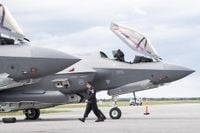OTTAWA — As Canada reassesses its plan to purchase 88 F-35 fighter jets from U.S. defense contractor Lockheed Martin, the implications of President Donald Trump’s tariffs loom large over the deal’s economic viability. The potential cancellation of the agreement has sparked discussions not only about military procurement but also about Canada’s broader defense strategy amid shifting geopolitical dynamics.
The F-35 Lightning II, a fifth-generation stealth aircraft, has been a centerpiece of defense discussions among allies. However, with mounting political pressures and budgetary constraints, several nations, including Canada, are reconsidering their commitments. Prime Minister Mark Carney’s government is currently evaluating whether to proceed with the $13.29 billion deal, which was signed in 2023, or to seek alternatives.
Canada’s Department of National Defence has clarified that the F-35 program is not canceled but is under review to ensure that it aligns with the best interests of Canadians and the Canadian Armed Forces. The first tranche of 16 jets, already paid for, is scheduled to arrive in early 2026, but concerns persist about the long-term implications of relying on U.S. technology.
Amid these uncertainties, the United Kingdom has opened the door for Canada to join the sixth-generation Global Combat Air Program (GCAP), a trilateral partnership that includes Japan and Italy. British Defense Minister Maria Eagle stated that while Canada is not currently a partner, there is an openness to collaboration. This invitation comes at a time when Canada is seeking to diversify its defense relationships beyond the United States.
During a parliamentary session, Liberal Democrat MP David Chadwick asked Eagle about the possibility of Canada’s involvement in the GCAP. “All three Global Combat Air Programme nations have highlighted an openness to working with other nations while keeping us on track with the program delivery schedule and helping us deliver future military capabilities,” Eagle responded, indicating a willingness to integrate Canada into future defense initiatives.
Prime Minister Carney’s recent diplomatic visits to France and the UK underscore the importance of these relationships. British Prime Minister Keir Starmer welcomed Carney, emphasizing the historical ties and shared values between the two nations. “The relationship between our two countries has always been strong,” Starmer remarked, highlighting the potential for enhanced military collaboration.
Currently, three active sixth-generation aircraft programs exist in the West: the American F-47, the GCAP, and the Future Combat Air System (FCAS) developed by France, Germany, and Spain. The F-47, which is being developed solely by the U.S., has raised eyebrows due to President Trump’s earlier comments about potentially limiting its export capabilities. He stated he would “tone down” the sixth-generation F-47 by 10% before exporting it to other countries, citing concerns about future alliances.
As Canada weighs its options, the prospect of joining the GCAP becomes increasingly appealing. The program aims to develop a next-generation combat aircraft equipped with advanced technology, including enhanced radar systems and potentially high-power microwave capabilities. The aircraft is expected to make its first flight in 2027 and be ready for induction by 2035.
The GCAP alliance, formed in 2022, seeks to combine the resources of the UK, Japan, and Italy to create a sixth-generation aircraft that can maintain a competitive edge in global markets. The newly established GCAP International Government Organization (GIGO), headquartered in the UK, will oversee the development of this cutting-edge fighter jet, which is designed for long-range combat and advanced situational awareness.
Despite the allure of the GCAP, Canada has not publicly specified which aircraft it may consider if it decides to abandon the F-35 deal. Currently, Europe does not have a fifth-generation fighter jet, but it does offer several 4.5th-generation options like the Rafale, Eurofighter Typhoon, and Gripen-E/F. The Carney government’s exploration of alternatives reflects a growing sentiment that Canada’s security relationship has been overly reliant on the U.S.
In a broader context, the F-35 program has faced scrutiny due to its high costs and technical challenges. The projected lifetime cost of the F-35 program has now exceeded $2 trillion, more than double the entire U.S. defense budget for 2024. With the U.S. planning to operate around 2,500 jets through the 2080s, some foreign partners are beginning to question the sustainability of their investments.
Portugal, for instance, has expressed hesitation about moving forward with its F-35 acquisition, citing concerns about the evolving geopolitical landscape and the predictability of U.S. policy under the Trump administration. Outgoing defense chief Nuno Melo remarked, “We cannot ignore the geopolitical environment in our choices,” emphasizing the need for strategic reassessment.
As Canada navigates these complex dynamics, the future of its defense procurement remains uncertain. The Carney government’s commitment to reviewing its options reflects a desire to ensure that Canada’s military capabilities are both effective and resilient in the face of changing global circumstances.
In summary, Canada’s decision on whether to proceed with the F-35 purchase or pursue alternatives like the GCAP will likely have significant implications for its defense posture and international relationships. As discussions continue, the outcome will shape Canada’s military strategy for years to come.







